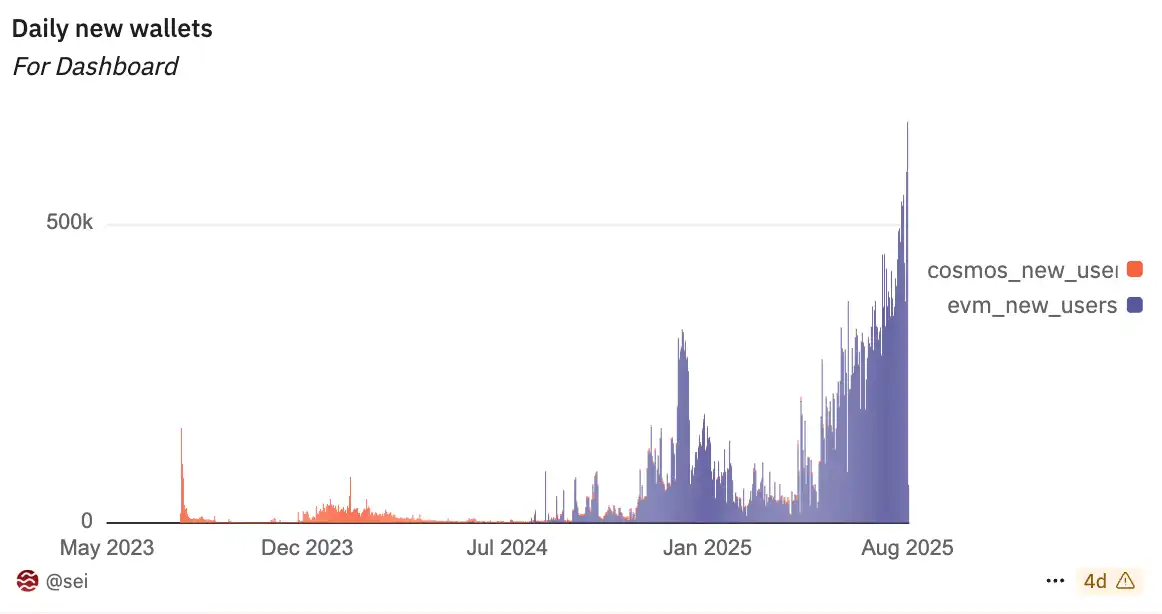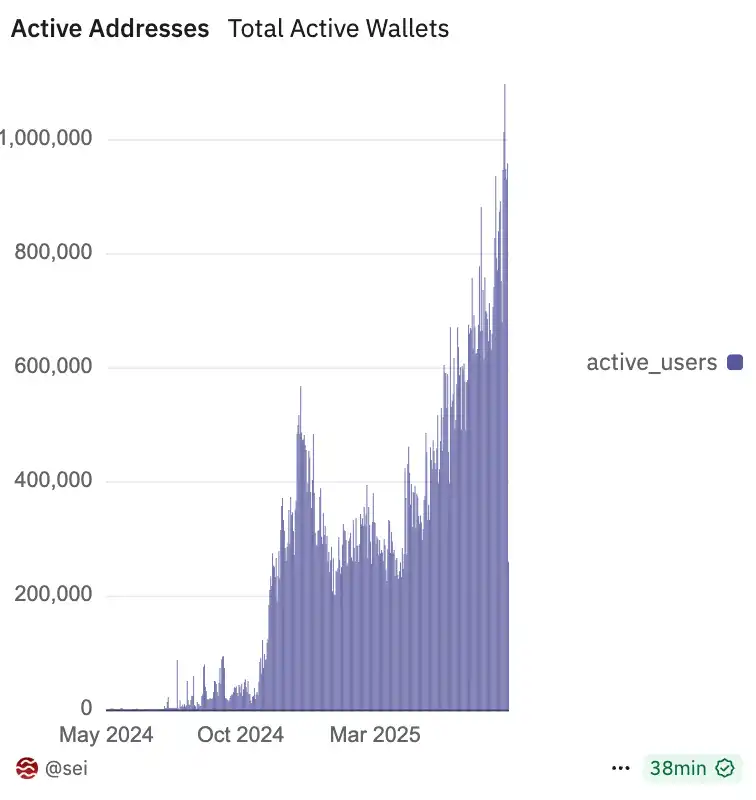ETH is approaching its historical high under the new treasury narrative, while traditional financial forces represented by Stripe and Circle have announced their entry into the market to create their own Layer 1 solutions. The EVM ecosystem has recently been thriving.
As the development tools, liquidity, and user networks of the Ethereum ecosystem gradually become the industry standard, compatibility with EVM has shifted from being a luxury to a basic requirement. Against this backdrop, Sei, which was once known for its high-performance order book chain, has chosen a different path. This article will review the key milestones of Sei's technological upgrades and ecological expansion over the past year and explore its long-term competitiveness in the reshaping of the multi-chain landscape.
EVM Upgrade and Infrastructure Integration
In mid-2024, Sei launched the V2 upgrade, officially introducing parallelized EVM to the mainnet. At the architectural level, it retains the modular advantages of the Cosmos SDK while enabling seamless interaction with Ethereum applications, maintaining existing network consensus and governance mechanisms, and establishing a bridge to the world's largest smart contract ecosystem. This move was quite counter-trend in the multi-chain environment at the time—while the vast majority of public chains were scaling back their R&D efforts, Sei was adding value in terms of performance and compatibility.
One of the supporting measures for the upgrade was establishing wallet compatibility with the EVM ecosystem infrastructure MetaMask. As the most widely used wallet globally, the integration of MetaMask significantly lowered the barriers for user migration and asset management, allowing users who were originally on Ethereum, Arbitrum, and other chains to enter Sei with almost zero learning cost.
Following this, the leading block explorer in the VM ecosystem, Etherscan, officially launched Sei, providing a customized Seiscan block explorer for Sei users and developers. This not only marked an important milestone in the improvement of the developer toolchain but also meant that on-chain data transparency would align with that of the Ethereum mainnet, providing a unified standard interface for debugging, auditing, and analysis. Rather than being a passive shift, this can be seen as Sei actively positioning itself in the reshaping of the multi-chain landscape—broadening the developer coverage and liquidity radius through performance, wallet access, and data visualization.
Since the launch of Sei V2, the Sei ecosystem has experienced explosive growth, with daily active users soaring from 1,300 to nearly 900,000, daily transaction volume increasing from 57,000 to 1.65 million, and TVL rising from $100 million to a recent peak of $687 million. For a public chain that was once deeply embedded in the Cosmos world but has actively opened up to a larger ecosystem, this is not only a reshaping of the growth curve but also a turning point in strategic narrative.
Why Upgrade?
Currently, Sei has supported both EVM and CosmWasm execution environments simultaneously, attempting to meet the needs of different developer groups through a "dual-track parallel" approach. This strategy provided flexibility in the early stages and made Sei one of the few networks capable of achieving native interoperability between EVM and WasmVM-based applications.
However, as the network scaled and the ecological structure changed, the costs of this architecture gradually became apparent. Users had to manage two sets of addresses, infrastructure providers needed to write custom logic for cross-environment interactions, and the codebase bore the long-term maintenance burden of cross-compatibility. Jay Jog, co-founder of Sei Labs, admitted that this complexity not only slowed down iteration speed but also diluted performance advantages.
Since the introduction of parallelized EVM in Sei v2, the usage of EVM has quickly dominated network activity. On-chain data from Dune Analytics shows that new users and newly deployed applications mostly choose the EVM environment, while the share of CosmWasm in transaction volume and development enthusiasm continues to decline.

For developers accustomed to the Solidity and Ethereum toolchain, EVM is not only a familiar programming interface but also carries mature debugging tools, a vast library of open-source components, and cross-chain portability—advantages that CosmWasm will find difficult to replace in the short term.
From developer psychology to ecological network effects, EVM has formed an unshakeable stickiness. In this context, continuing to maintain a dual architecture not only lost its original strategic significance but also consumed valuable R&D and maintenance resources.
Thus, the SIP-3 proposal emerged, a proposal launched by Sei Labs that directly points to a single goal—transitioning Sei to an EVM-only architecture, completely abandoning CosmWasm contracts and native Cosmos transactions.
The plan will be implemented in phases, starting with establishing a pointer mechanism on the EVM side to allow existing Cosmos and CosmWasm assets to be accessed, then freezing new CosmWasm deployments and inbound IBC asset flows, and finally discontinuing the execution of old contracts and support for non-EVM address transactions.
Sei addresses will not disappear entirely; they will still play a role in validator identity, staking, and governance within protocol internal processes, and these functions will be realized through EVM precompiles, ensuring the continuity of on-chain governance.
Proactive Breakthrough: How Does Sei Enter EVM?
The core of the upgrade measures lies in the dual management of technical execution and ecological migration. The Sei team has clearly broken this process down into controllable phases to minimize the impact on the existing ecosystem. Technically, optimistic parallelization remains the core of Sei's performance, allowing transactions to run simultaneously and only reverting to sequential execution mode when conflicts are detected.
The Twin Turbo consensus mechanism compresses block finality time to about 360 milliseconds, thousands of times faster than Ethereum, providing solid performance guarantees for high-frequency interactions in DeFi, gaming, and order book applications, meaning users experience almost no latency; SeiDB's layered storage structure continues to support efficient state access and historical data queries.
In terms of infrastructure adaptation, MetaMask has become an important user entry point for Sei, while Etherscan has filled the gap in on-chain data browsing and developer debugging.
The parallel construction of these two facilities with cross-chain bridges, data indexing, multi-signature accounts, etc., enables Sei to provide a development experience comparable to or even surpassing that of the Ethereum mainnet in a short time. For CosmWasm developers, the official team will provide migration guides and technical support to ensure applications can smoothly transition to EVM-compatible forms. Asset holders can transfer native Cosmos assets to EVM wallets through cross-chain bridges or exchanges, reducing liquidity loss.
Sei's EVM-only Era: The Bet on Speed and Compatibility
The changes in data validate the effectiveness of this transformation. Since the V2 upgrade, the number of daily active wallets on Sei has increased from 1,300 to nearly 900,000, daily transaction volume has surged from 57,000 to 1.65 million, and TVL has risen from $100 million to a peak of $687 million.

This growth is reflected not only in on-chain data but is also gradually transmitting to the traditional financial system. In May 2025, Canary Capital submitted the S-1 filing for the Staked SEI ETF, indicating that Sei is expected to become one of the few blockchains that can be included in compliant asset portfolios. Meanwhile, the Sei Development Foundation, established in the United States, ensures the robustness of governance in terms of development direction, policy alignment, and compliance advancement.
In early August, according to @EmberCN monitoring, the number of daily active users on the Sei network first surpassed that of the Solana network on August 2. Sei recently launched native USDC and introduced Ondo and Backpack, leading to a significant increase in adoption, with daily active users doubling in the last three months—from 380,000 to the current 752,000. Additionally, in just 10 days, the issuance of native USDC on Sei reached $108 million, surpassing chains like zkSync, Algorand, and Polkadot.
Related Article: "When the First Stablecoin Meets High-Performance Layer 1, Why Does Sei Stand Out?"
In this way, Sei is poised to become a truly on-chain platform aimed at traditional capital markets. Against the backdrop of the emergence of next-generation on-chain assets such as stablecoins, RWA, and DePIN, Sei's characteristics of "high throughput + regulatory compliance + easy access" have secured it a proactive role in ecological evolution.
By aligning with the dominant position of the EVM ecosystem among developer communities and leveraging Sei's technological accumulation in parallel execution and low-latency consensus, it attempts to find a new balance between performance and ecology. Ultimately, the success or failure of this upgrade depends not only on the smooth implementation of technology but also on the degree of coordination in ecological migration—whether existing users and applications can switch with minimal friction and continue to expand under the new EVM-only architecture.
From a broader perspective, Sei's transformation reflects a trend in the entire industry; in a multi-chain coexistence landscape, EVM remains the default standard in the minds of developers. Whether due to technical familiarity, toolchain maturity, or ecological network effects, the appeal of EVM has led many emerging chains to choose active compatibility. Sei's innovation on this basis attempts to fill the gaps in high-frequency application scenarios that Ethereum and its L2 solutions face with faster performance and lower latency. For developers and capital looking to find the best combination of speed and compatibility in the Web3 world, this may be the answer they are seeking.
As the planning of the Giga architecture gradually progresses, Sei hopes to elevate performance to a new level and continuously expand application boundaries in high-frequency scenarios such as finance, AI, gaming, and social interactions. In the reshuffling of the multi-chain landscape, speed, liquidity, and ecological breadth may determine the future of a public chain.
Sei's choice places it at the center of the industry's most competitive arena—where opportunities are vast, but the margin for error for failures is minimal. Its next growth curve depends on whether it can not only survive in the red ocean of the EVM world but also become an important infrastructure driving the next wave of application trends.
免责声明:本文章仅代表作者个人观点,不代表本平台的立场和观点。本文章仅供信息分享,不构成对任何人的任何投资建议。用户与作者之间的任何争议,与本平台无关。如网页中刊载的文章或图片涉及侵权,请提供相关的权利证明和身份证明发送邮件到support@aicoin.com,本平台相关工作人员将会进行核查。




